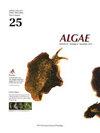Consensus channelome of dinoflagellates revealed by transcriptomic analysis sheds light on their physiology
IF 2.4
3区 生物学
Q1 MARINE & FRESHWATER BIOLOGY
引用次数: 4
Abstract
Ion channels are membrane protein complexes mediating passive ion flux across the cell membranes. Every organism has a certain set of ion channels that define its physiology. Dinoflagellates are ecologically important microorganisms characterized by effective physiological adaptability, which backs up their massive proliferations that often result in harmful blooms (red tides). In this study, we used a bioinformatics approach to identify homologs of known ion channels that belong to 36 ion channel families. We demonstrated that the versatility of the dinoflagellate physiology is underpinned by a high diversity of ion channels including homologs of animal and plant proteins, as well as channels unique to protists. The analysis of 27 transcriptomes allowed reconstructing a consensus ion channel repertoire (channelome) of dinoflagellates including the members of 31 ion channel families: inwardly-rectifying potassium channels, two-pore domain potassium channels, voltage-gated potassium channels (Kv), tandem Kv, cyclic nucleotide-binding domain-containing channels (CNBD), tandem CNBD, eukaryotic ionotropic glutamate receptors, large-conductance calcium-activated potassium channels, intermediate/small-conductance calcium-activated potassium channels, eukaryotic single-domain voltage-gated cation channels, transient receptor potential channels, two-pore domain calcium channels, four-domain voltage-gated cation channels, cation and anion Cys-loop receptors, small-conductivity mechanosensitive channels, large-conductivity mechanosensitive channels, voltage-gated proton channels, inositole-1,4,5- trisphosphate receptors, slow anion channels, aluminum-activated malate transporters and quick anion channels, mitochondrial calcium uniporters, voltage-dependent anion channels, vesicular chloride channels, ionotropic purinergic receptors, animal volage-insensitive cation channels, channelrhodopsins, bestrophins, voltage-gated chloride channels H+/Cl- exchangers, plant calcium-permeable mechanosensitive channels, and trimeric intracellular cation channels. Overall, dinoflagellates represent cells able to respond to physical and chemical stimuli utilizing a wide range of Gprotein coupled receptors- and Ca2+-dependent signaling pathways. The applied approach not only shed light on the ion channel set in dinoflagellates, but also provided the information on possible molecular mechanisms underlying vital cellular processes dependent on the ion transport.转录组学分析揭示了鞭毛藻的共识通道体,揭示了鞭毛藻的生理特征
离子通道是介导被动离子穿过细胞膜的膜蛋白复合物。每个生物体都有一组特定的离子通道来定义其生理机能。甲藻是一种具有重要生态意义的微生物,其特征是具有有效的生理适应性,这支持了它们的大规模繁殖,通常会导致有害的水华(赤潮)。在这项研究中,我们使用生物信息学方法来鉴定属于36个离子通道家族的已知离子通道的同源物。我们证明,甲藻生理学的多功能性是由高度多样的离子通道支撑的,包括动物和植物蛋白质的同源物,以及原生生物特有的通道。对27个转录组的分析允许重建甲藻的共有离子通道库(通道组),包括31个离子通道家族的成员:内向整流钾通道、两个孔结构域钾通道、电压门控钾通道(Kv)、串联Kv、含环核苷酸结合结构域通道(CNBD)、串联CNBD,真核离子型谷氨酸受体、大电导钙激活钾通道、中/小电导钙激活的钾通道、真核单结构域电压门控阳离子通道、瞬时受体电位通道、两孔结构域钙通道、四结构域电压栅极阳离子通道、阳离子和阴离子Cys环受体,小导电性机械敏感通道、大导电性机械敏感性通道、电压门控质子通道、肌醇1,4,5-三磷酸受体、慢阴离子通道、铝激活的苹果酸转运蛋白和快速阴离子通道、线粒体钙单转运蛋白、电压依赖性阴离子通道、囊泡氯通道、离子型嘌呤能受体,动物体积不敏感的阳离子通道、通道视紫红质、富营养素、电压门控氯离子通道H+/Cl-交换器、植物钙渗透性机械敏感通道和三聚体细胞内阳离子通道。总的来说,甲藻代表能够利用广泛的G蛋白偶联受体和Ca2+依赖性信号通路对物理和化学刺激做出反应的细胞。该应用方法不仅揭示了甲藻中的离子通道,还提供了依赖离子转运的重要细胞过程的可能分子机制的信息。
本文章由计算机程序翻译,如有差异,请以英文原文为准。
求助全文
约1分钟内获得全文
求助全文
来源期刊

Algae
PLANT SCIENCES-
CiteScore
5.10
自引率
25.00%
发文量
18
期刊介绍:
ALGAE is published by the Korean Society of Phycology and provides prompt publication of original works on phycology. ALGAE publishes articles on all aspects of phylogenetics and taxonomy, ecology and population biology, physiology and biochemistry, cell and molecular biology, and biotechnology and applied phycology. Checklists or equivalent manu-scripts may be considered for publication only if they contribute original information on taxonomy (e.g., new combinations), ecology or biogeography of more than just local relevance. Contributions may take the form of Original Research Articles, Research Notes, Review Articles and Book Reviews.
 求助内容:
求助内容: 应助结果提醒方式:
应助结果提醒方式:


